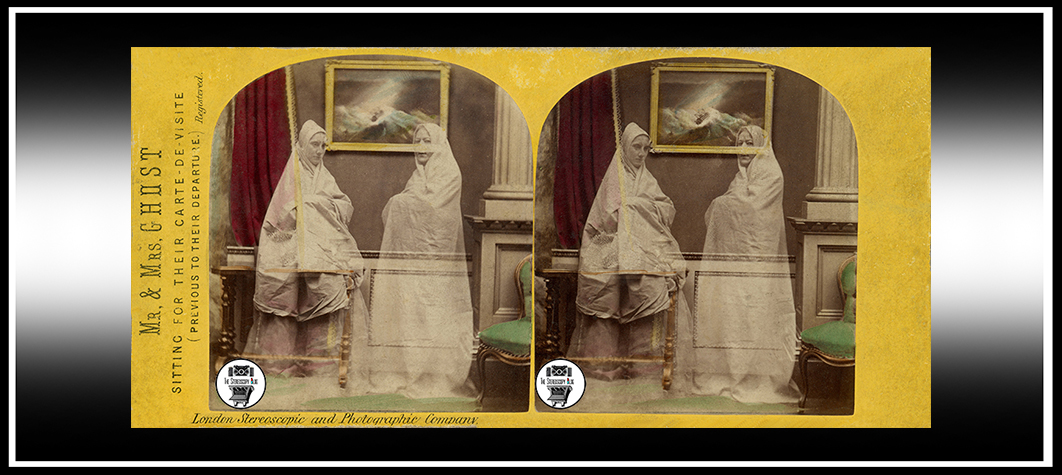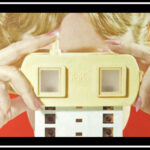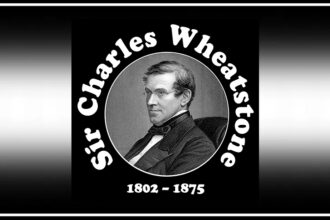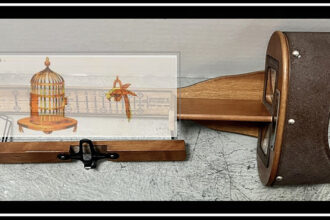To commemorate Sir Charles Wheatstone on the 150th anniversary of his death, I thought I’d share a post to try to take a sledgehammer to some of the enduring myths of stereoscopy.
Many myths about the first thirty years of stereoscopy are said to have been laid to rest with this publication Stereoscopy: Dawn of 3-Dwritten by Denis Pellerin and edited by Brian May, and published by the London Stereoscopic Company in 2021; yet here we are, in 2025, still finding at least two recently published texts continuing to show some proven errors. Let’s get to work!
Myth: Stereoscopy was popularized by Queen Victoria after she saw a Brewster-type stereoscope and some stereoscopic drawings by Jules Duboscq at the Great Exhibition of 1851, whose portrait was taken there, which she presented with a stereoscope. This led to hundreds of thousands of stereoscopic images being produced soon after to meet public demand.
Fact: Part of the myth appears to have been started by Sir David Brewster in print in May 1852, and continued in his 1856 book. Stereoscopes, Theory and Constructionand many more publications have been reproduced and added to it. Denis Pellerin, photo historian, writes Stereoscopy: Dawn of 3-D that no real evidence has been found that Queen Victoria even saw a stereoscope or Duboscq’s drawings at the 1851 exhibition, but she purchased a stereoscope from Antoine Claudet in late 1852. Pellerin also states that the stereoscopic craze actually began in late 1856. You have to remember the context in which the photographic process was available when, and, in turn, when stereoscopic photographs and stereoscopes could be used. produced substantially and commercially, so that it is affordable enough for the public, when public demand is there.
Myth: The stereoscope was invented by Sir David Brewster/James Elliot in 1834.
Fact: It was Sir David Brewster who spread the myth about Elliot inventing the stereoscope, and there was a public argument in the newspapers in the 1850s between Brewster and Wheatstone that dispelled this myth. Ultimately, Wheatstone and others proved that Wheatstone discovered the (reflecting) stereoscope in 1832, but he did not present his paper on the physiology of vision and demonstrate the stereoscope at the Royal Society until 1838. Brewster himself wrote in 1861:
| ‘I think it’s right to state that to you I’m not the inventor from Stereoscope. I am simply the inventor of the Lenticular Stereoscope which is now in universal use.’ |
Even this assertion, however, may be called into question given Wheatstone’s early refractive and lenticular stereoscopes in the King’s College London Archives collection, but proving an early production date may be more difficult. Brewster’s greatest innovation with the stereoscope design was cutting the lens in half, to make each half used for each eye in the stereoscope almost optically identical, but this design was also criticized by others because it was said to limit the size of the lens. Source of facts: Stereoscopy: Dawn of 3-D.
I’ve also read in recent years that Sir David Brewster is considered the ‘father of VR’. See above, it’s Wheatstone; he even regularly dazzles at the Royal Society wearing a VR headset (OK, I exaggerate). NB The company that perpetuated the Brewster VR myth, and unfortunately named itself after it, has ceased trading.
Myth: Oliver Wendell Holmes coined the term ‘Stereograph’ / ‘Stereoscope’.
Fact: The source of the claim of the creation of the ‘stereograph’ is Oliver Wendell Holmes’ June 1859 text ‘The Stereoscope and the Stereograph’, Atlantic Monthlyp738-748:
| ‘We have now obtained a double-edged or twin-edged image, or stereograph, if we may give it a name.’ |
It is important to note here, that in the same text, Holmes also uses ‘stereoscopic image’, ‘stereoscopic view’, ‘stereoscopic doublet’, ‘stereoscopic photograph’, ‘paper stereograph’, and ‘glass stereograph’, interchangeably, as necessary. The ‘stereograph’ was already in popular use before Holmes says he invented it; one example can be found in That Stereoscopic Magazinepublished in 1858 by Lovell Augustus Reeve, in which ‘stereograph’ is used consistently throughout. Thanks to Professor Roger Taylor and De Montfort University, you can also see this term already used in a British photography exhibition in 1858.
‘Stereoscope’ is obviously the term given to, erm, the stereoscope, by its inventor, Sir Charles Wheatstone, in his 1838 paper, where he stated:
| “This inconvenience is removed by the instrument I will describe; viz two images (or rather their reflected images) are placed in it in their actual places optical axis, the eye’s focusing adaptation maintains its usual adjustment, i.e The appearance of lateral images is completely avoided, and the field of view is wide for each eye obtained. The references I often give to this instrument, it would be easier to give it a specific name, therefore I propose that it be called a Stereoscopeto show its properties representing solid numbers.” |
Source: Charles Wheatstone, ‘Contributions to the physiology of vision. —First part. About some extraordinary and hitherto unobserved phenomena of binocular vision.’ Philosophical Transactions of the Royal Society of LondonDecember 1838, Vol. 128, p371-394.
Myth: Many American stereoscopic photographs have curved mounts so that the image has more 3-D depth/so that the photographic image is not smeared when placed face down.
Fact: In a recent article, author Nancy Nehring states that the curved card holder was introduced by Kilburn Bros in 1877. She has extensively searched for available clues, and Kilburn Bros apparently never claimed that the curve produced the effect of additional depth or improvement in appearance. I don’t want to add too many spoilers, but Nancy states that Kilburn redesigned his stereograph in 1877, and it was the way it was made that caused the warping. Source: To read the full article, please see the National Stereoscopic Association magazine Stereo WorldJuly/August 2025, Vol. 51, No.1, p26-30.
Myth: The main pioneer of stereoscopic photography was *insert name of stereoscopic photographer later*.
Fact: To put this in the context of pioneering stereoscopic photographers, Wheatstone commissioned stereoscopic photographs from William Henry Fox Talbot in 1840, and in 1841 from Henry Collen, the studio of Richard Beard, and M. Fizeau. He also commissioned Antoine Claudet to make a stereoscopic daguerreotype in the 1840s, then offered it commercially in 1851. Louis Jules Duboscq is said to have made stereoscopic photographs of Brewster and the stereoscope he designed in 1850, and then offered a catalog in 1852, with known examples of him commissioning other French photographers to take pictures stereoscopic. The London Stereoscope Company, as it was then called, reportedly began in 1854, when several stereoscopic photographs brought from France were displayed in the window of the Art Repository. They then advertised ‘groups and displays’ for stereoscopes for sale in 1855, and offered a thousand displays in August of that year. Source: Stereoscopy: Dawn of 3-D.
Myth: To create a 3-D photo, you can paste two exact copies of the same image side by side.
Fact: When you photograph a subject and move the camera from left to right between photos, or take a scene simultaneously using two horizontally spaced lenses, for example with a stereoscopic camera, the subtle difference in perspective that shows a shift in the position of an object when viewed from different points is called parallax. A good example is if you point your fingers in front of your face and cover each eye separately to see changes in what you can see behind your hand, and also which areas of your fingers you can see with each eye. You need perspective shift, or parallax, to be able to produce a 3-D effect, which your brain interprets as you see two images simultaneously but separately with each eye. If you use the exact same photo on the left and right, you can certainly blend them, but the result will be a single flat image rather than a single 3-D image. This also includes if you are scanning a mono image, move it slightly to the right on the scanner and scan again. Yes, I’ve read it.
I should also add here that squinting or cross-looking at images that should appear parallel will cause the images to appear inverted, and vice versa. I once heard visitors to an exhibition described as being unenthusiastic about the stereoscopic images on display, and apparently the institution had not checked whether the images they were distributing were cross-viewed or parallel-viewed images, meaning the images were a mix, and the poor visitors were made to view the cross-viewed images with a stereoscope designed for parallel viewing. Please check the pictures first before you think the complaints are because people don’t like seeing things in 3-D!
This post will be updated when I have more time, but feel free to add or suggest any additions in the comments.
By chance, to create Stereoscopy: Dawn of 3-D more accessible, and to help bring the well-researched facts about the first thirty years of stereoscopy to more people, The London Stereoscopic Company is kindly offering a 25% discount on the book for three weeks around the 150th anniversary of Wheatstone’s death. Offer ends on October 25, 2025, please see their website for more details.
Copyright © Stereoscopy Blog. All rights reserved.
News
Berita
News Flash
Blog
Technology
Sports
Sport
Football
Tips
Finance
Berita Terkini
Berita Terbaru
Berita Kekinian
News
Berita Terkini
Olahraga
Pasang Internet Myrepublic
Jasa Import China
Jasa Import Door to Door




